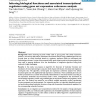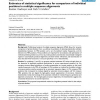844 search results - page 166 / 169 » Further results on concordance relations |
BMCBI
2007
14 years 11 months ago
2007
Background: Gene clustering has been widely used to group genes with similar expression pattern in microarray data analysis. Subsequent enrichment analysis using predefined gene s...
FSS
2006
14 years 11 months ago
2006
Among the various extensions to the common [0, 1]-valued truth degrees of "traditional" fuzzy set theory, closed intervals of [0, 1] stand out as a particularly appealin...
109
click to vote
IM
2007
14 years 11 months ago
2007
PageRank is a popularity measure designed by Google to rank Web pages. Experiments confirm that PageRank values obey a power law with the same exponent as In-Degree values. This ...
92
Voted
BMCBI
2005
14 years 11 months ago
2005
Background: In the analysis of microarray data one generally produces a vector of p-values that for each gene give the likelihood of obtaining equally strong evidence of change by...
103
click to vote
BMCBI
2004
14 years 11 months ago
2004
Background: Profile-based analysis of multiple sequence alignments (MSA) allows for accurate comparison of protein families. Here, we address the problems of detecting statistical...




